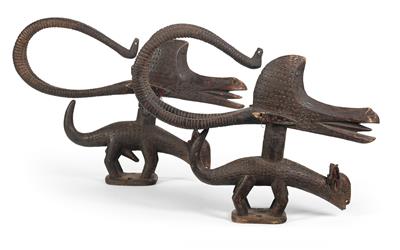Bambara (or Bamana), Mali: a pair of horizontal dance crests, ‘Chiwara’, (2 items), female and male, ‘composed’ from two different animals. Style: In the style of the Sikasso or Bougouni region.
Bambara (or Bamana), Mali: a pair of horizontal dance crests, ‘Chiwara’, (2 items), female and male, ‘composed’ from two different animals. Style: In the style of the Sikasso or Bougouni region.

Among the Bambara workers of the land in the savanna of Mali, it is customary that two boys should dance with these ‘antelope crests’ on their head before the seed-sowing season. The aim of the ritual is to increase and secure fertility. One crest depicts a female antelope, while the other depicts a male. During the dance, the ‘Chiwara’ (also spelled ‘Chi wara’) are tied to plaited caps. The present, distinct but connected ‘Chiwara pair’ constitute a special case and stylistic mix. On the one hand, both figures are in keeping with the ‘horizontal type’ of antelope crests. Each mask has a pair of backward-sweeping horns. This type is typical of the region around the town of Sikasso in Mali. On the other hand, they are both ‘Chiwara’ hybrid creatures, formed from two different animals. The large heads of the antelopes ‘sit’ here on the bodies of aardvarks. This style of combining different animals together occurs predominantly in the Bougouni region.
Both items are old and it is clear they have often been used in dances. They are carved from light-coloured, lightweight yet hard wood and are of dark brown colour. Each crest is assembled from two parts: their large hippotragina (horse antelope) heads – each with two extremely heavy, (backwards-sweeping) horns, metal eyes, open jaws and relief decoration – are connected to the aardvarks below at the neck with two iron clips. The ears of both animals are pierced and decorated with red string tassels. Both display a good, partly shiny patina, noticeable traces of use and some age-related damage. There is an original repair (one broken horn fixed by means of an iron clip). Three of the eight ears show cracks, the nose and other exposed areas are chipped (from wild dances) and the holes in the rounded base plate of both items show traces of where the ‘Chiwara’ were attached to plaited caps. Height: c. 40 cm; length: 49 cm. First half of the 20th century. (ME)
Provenance:
German private collection.
Lit.:
'Bamana. Afrikanische Kunst aus Mali’ by Jean-Paul Colleyn, Rietberg Museum Zurich, ill. 214, 220, 221 (horizontal style), and 230 (composite style with aardvark).
Expert: Prof. Erwin Melchardt
 Prof. Erwin Melchardt
Prof. Erwin Melchardt
+43-1-515 60-465
erwin.melchardt@dorotheum.at
09.06.2016 - 17:00
- Vyvolávací cena:
-
EUR 1.200,-
Bambara (or Bamana), Mali: a pair of horizontal dance crests, ‘Chiwara’, (2 items), female and male, ‘composed’ from two different animals. Style: In the style of the Sikasso or Bougouni region.
Among the Bambara workers of the land in the savanna of Mali, it is customary that two boys should dance with these ‘antelope crests’ on their head before the seed-sowing season. The aim of the ritual is to increase and secure fertility. One crest depicts a female antelope, while the other depicts a male. During the dance, the ‘Chiwara’ (also spelled ‘Chi wara’) are tied to plaited caps. The present, distinct but connected ‘Chiwara pair’ constitute a special case and stylistic mix. On the one hand, both figures are in keeping with the ‘horizontal type’ of antelope crests. Each mask has a pair of backward-sweeping horns. This type is typical of the region around the town of Sikasso in Mali. On the other hand, they are both ‘Chiwara’ hybrid creatures, formed from two different animals. The large heads of the antelopes ‘sit’ here on the bodies of aardvarks. This style of combining different animals together occurs predominantly in the Bougouni region.
Both items are old and it is clear they have often been used in dances. They are carved from light-coloured, lightweight yet hard wood and are of dark brown colour. Each crest is assembled from two parts: their large hippotragina (horse antelope) heads – each with two extremely heavy, (backwards-sweeping) horns, metal eyes, open jaws and relief decoration – are connected to the aardvarks below at the neck with two iron clips. The ears of both animals are pierced and decorated with red string tassels. Both display a good, partly shiny patina, noticeable traces of use and some age-related damage. There is an original repair (one broken horn fixed by means of an iron clip). Three of the eight ears show cracks, the nose and other exposed areas are chipped (from wild dances) and the holes in the rounded base plate of both items show traces of where the ‘Chiwara’ were attached to plaited caps. Height: c. 40 cm; length: 49 cm. First half of the 20th century. (ME)
Provenance:
German private collection.
Lit.:
'Bamana. Afrikanische Kunst aus Mali’ by Jean-Paul Colleyn, Rietberg Museum Zurich, ill. 214, 220, 221 (horizontal style), and 230 (composite style with aardvark).
Expert: Prof. Erwin Melchardt
 Prof. Erwin Melchardt
Prof. Erwin Melchardt
+43-1-515 60-465
erwin.melchardt@dorotheum.at
|
Horká linka kupujících
Po-Pá: 10.00 - 17.00
kundendienst@dorotheum.at +43 1 515 60 200 |
| Aukce: | Mimoevropské a domorodé umění |
| Typ aukce: | Salónní aukce |
| Datum: | 09.06.2016 - 17:00 |
| Místo konání aukce: | Wien | Palais Dorotheum |
| Prohlídka: | 04.06. - 09.06.2016 |
